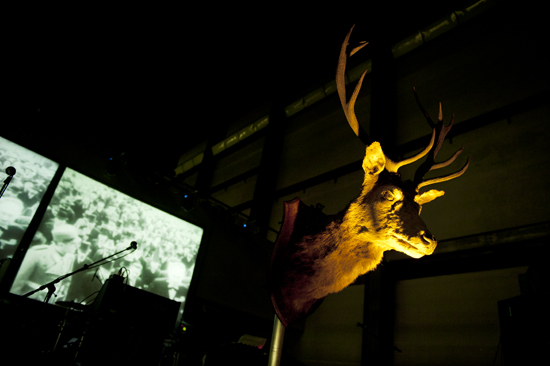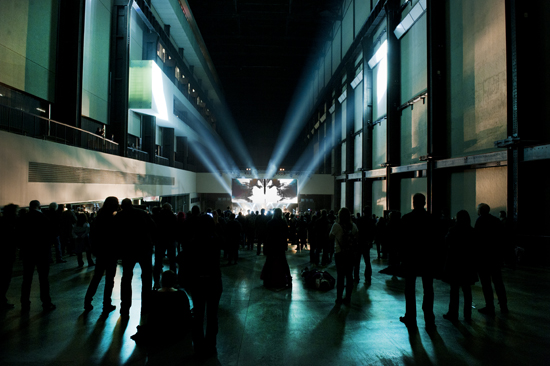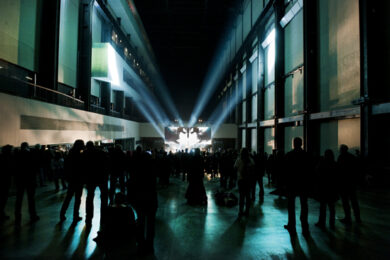In December 1990, Laibach played a concert at one of the three power stations in their Slovenian home town of Trbovlje. Though it wasn’t the plant in the city that boasts the tallest chimney in Europe, it was a structure even bigger than turbine hall of the Tate Modern, but decrepit and nearly derelict. Laibach played in minus-17 temperatures, tea and rum served to attendees. The concert was so loud pieces of roof constantly rained down on group and audience alike. The fathers of some of the band members donned the overalls they had worn as workers at the power plant to act as Laibach’s crew. The event marked not only ten years of Laibach, but the birth of an independent Slovenian state, voted in by plebiscite just days before. It was a historical moment that Laibach, with their agitating around Slovenian identity, arguably helped to bring about.
Yet they remain one of the most misunderstood groups of our age. In the Divided States of America US tour film, one confused American asks "I think it was neo-fascist but I’m not sure if it was a joke or not. Do you know?" Laibach have always dealt in the confused identities, ambiguities, and potential nightmares and utopias of national identity. These are the themes explored in today’s talks and seminars around the operations and theories of the NSK, or Neue Slowenische Kunst, the Slovenian art movement of which Laibach make up the musical wing and which, after the fall of Marshall Tito, formed a "parallel world to that enforced by the communist party", according to speaker Anthony Gardner. They combine to give an excellent primer to the evening’s musical events.
Laibach rarely give interviews, preferring to communicate as one voice, as the voice on early track ‘Perspektive’: "Laibach takes over an organizational system of work after the model of industrial production and totalitarianism. Collective spirit identification with ideology, which means not the individual but the organization speaks. Our work is industrial, our language political."
Where Laibach’s following of the methodologies of propaganda meant they generally give everything and nothing, Novak’s discussion with NSK expert Alexei Monroe gives a rare insight into their history, philosophies and driving ideologies. For instance, unlike most of the Western industrial groups Laibach actually had experience in industry, working in Trbovlje’s cement factories, which led to an understanding and appreciation of repetition and monotony. "There would be no Laibach without the cement factory," Novak insists.
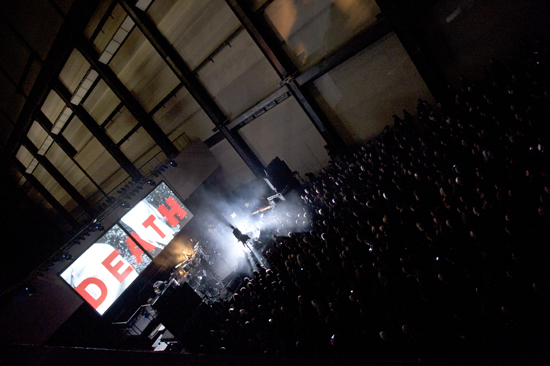
Suspicious of the uniforms worn by the group? The members of Laibach and the NSK were of course required to carry out military service in Yugoslav army. When they made illegal nocturnal forays from their barracks to go to gigs and art shows, they would of course be wearing uniforms. These would then be customized, perhaps with a badge or armband. Their first Laibach uniforms (along with smoke bombs used for special effects at early performances) were purloined from the army at the end of Novak’s service. This was an aesthetic defined out of necessity.
Uniforms were therefore a means of communication, and anyway entirely appropriate for Laibach’s intentions. "I always understood rock bands as a military formation," Novak states. "The Beatles and Rolling Stones were dressed in uniforms, long hair and jeans. They are selling an ideology, subjugating the audience so they go to the shop to buy the record." The great Western myth of rock & roll’s radicalism was subverted by Laibach in their appropriation of pop hits, from Queen’s ‘One Vision’ ("we were frustrated by the overwhelming performances of Freddie Mercury. He was everything we wanted to be") to The Rolling Stones’ ‘Sympathy For The Devil’ and the whole of the Beatles’ Let It Be album. With Slovenia independent and Europe reuniting, Laibach since the 1990s have turned their attention to the West, to the unsafe sanctity of our democracies enslaved to neo-liberalism and high capital. Why was it necessary to take on Western pop culture? "Because it was everywhere," Novak states. "The strongest weapons of capitalism were Hollywood films and pop music. We had to develop a counter."
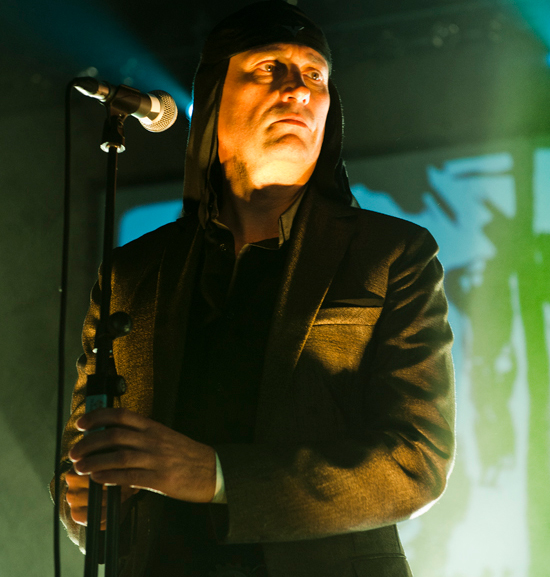
The timing of Laibach’s presence in the turbine hall of the Tate Modern is therefore fortuitous. With the decline of Western pop as a financial force and the end of Hollywood’s romantic era, it’s arguable that it has been replaced by the collection of high-concept art. Just on the other side of the walkway that divides this cavernous space, in a squat black bunker, sits the diamond-encrusted bauble that is Damien Hirst’s skull. As the shadow cast by Laibach singer Milan Fras rises stories high up the southern wall of the turbine hall, you half wish that it’d reach backwards and grab the skull for an "alas poor Yorick".
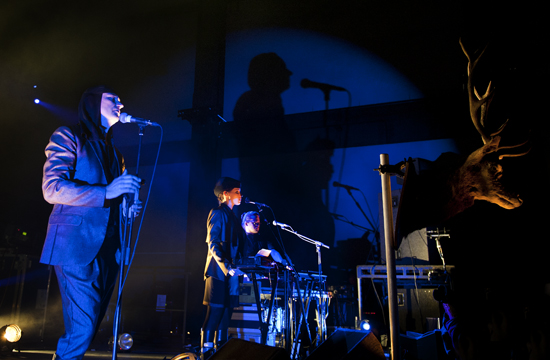
On top of the PA system, three TVs each show early Laibach footage. The screens behind the group flicker with an old propaganda film. To begin, Laibach play their more recognisably industrial music from their early years (as collected on the Rekapitulacija album). Tonight, this features members who have not been seen onstage for years – as befits the industrial, production line aesthetic, the group plays with an ever-evolving set of workers, with Novak generally behind the mixing desk. It’s an effective play not only on totalitarianism’s idealisation of the clean-limbed youth, but rock & roll’s neophilic fetisisation of teenagers.
This one-off, cross-generational line-up begins with retro-totalitarian evening news fragments and exhorting song. Clarinet, drums and rhythm become louder and heavier as the footage on the screens intensifies, but runs in reverse – D-Day, paratroopers rising from cornfields under silk mushrooms and heading into the sky, water running backwards past blown bridges, people walking back through their front doors, hands raised. It’s deeply unsettling. At another moment, a bare-but-hairy-shouldered man in black steelwork/Laibach/butcher apron throat gargles into a mic as a piano descends into dischord and noise. Interestingly, heard in 2012 this ominous, darkly rhythmic music sounds like an anticipation of contemporary groups like Raime and The Haxan Cloak.
Tonight is billed as Laibach playing "Retro monumental avant-garde" as if to suggest that we cannot understand our present and define a coherent future without comprehending, fearing, subverting and laughing at our past. This is more considered, structured, deliberate than any Laibach performance I have seen, a reflection of and twist on the age of blaring sensationalism represented in the galleries above. Slogans – which pass across the screens throughout – are combined with this potent sonic onslaught, far more effective than the faux-naive waffle (so well dissected by Joe Kennedy here) that dominates the form in the self-conscious urban postcodes of London and New York.
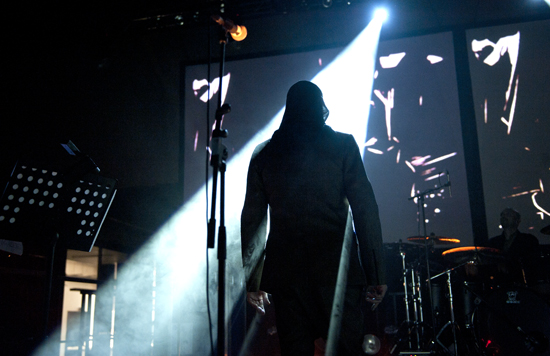
The second section, dominated by Laibach’s pop appropriation pomp, is heralded with harpsichord keys doing the Beatles ‘Across The Universe’, It ends with a rising V2 rocket, and then the Iron Sky footage of the space Nazis’ biggest ship rising from the moon, as Laibach play the oil-and-hammers anthem ‘B-Mashina’ and the techno calisthenics belter ‘Tanz Mit Laibach’. Then there’s the brilliant cover of The Normal’s ‘Warm Leatherette’ and ‘Leben Heisst Leben’ and their conclusion, a quietly menacing version of Bob Dylan’s ‘Ballad Of A Thin Man’.
This is a reminder that the never-ending cultural obsession with British or American art school groups is a sideline to far more radical achievements elsewhere in the world. Laibach are born out of what they are made of – cement – and hold no respect for taste or the market. Not only are Laibach an extra-state entity, they’re a collector-proof art construct and label-drop-resistant band. They survived and adapted and redeployed for post-Tito, post-Yugoslav, post-Communist and now, perhaps, they offer new thoughts as we stand teetering on brink of a post-capitalist and possibly post-Euro world. Where once they offered a parallel to the communist state, Laibach and NSK give us a mirror and critique to late capitalist life and art. As the group leave to the last echoes around the turbine hall, Laibach’s stag’s head, stood throughout the gig in the centre of the stage, appears curiously proud… a glorious and noble contrast to the inane grin of Hirst’s gaudy skull.
